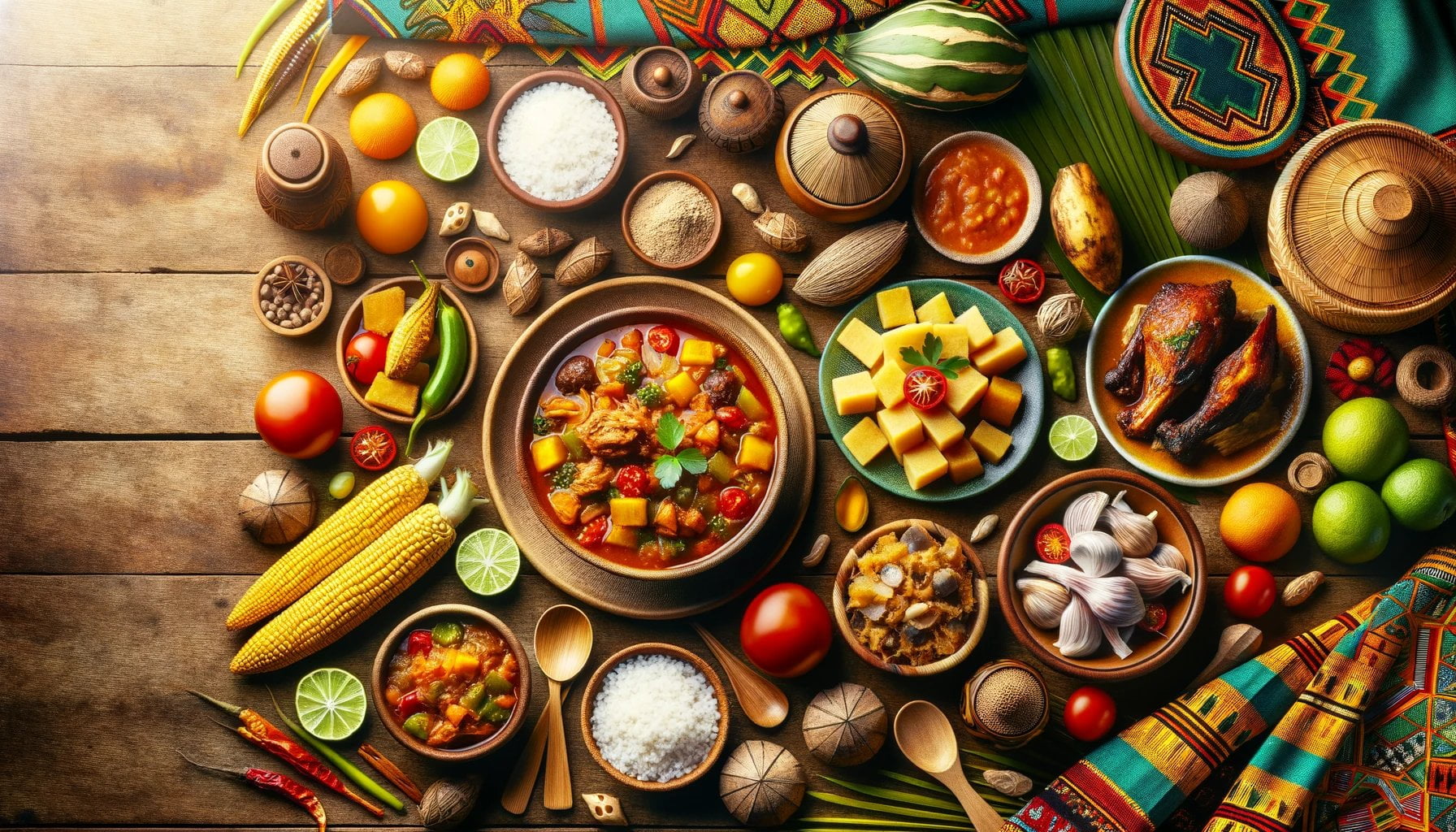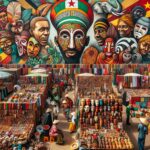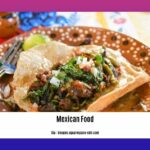Get ready to embark on a culinary adventure that will leave your taste buds dancing with delight! We’re diving into the tantalizing flavors of Angola, a treasure trove of African traditions, Portuguese flair, and unique ingredients that will ignite your senses. From the national dish of funge to the irresistible street food, let’s uncover the culinary wonders that await in this captivating Southern African country. Join us on a gastronomic journey that will introduce you to the rich history, cultural significance, and unforgettable flavors of Angola’s culinary heritage.
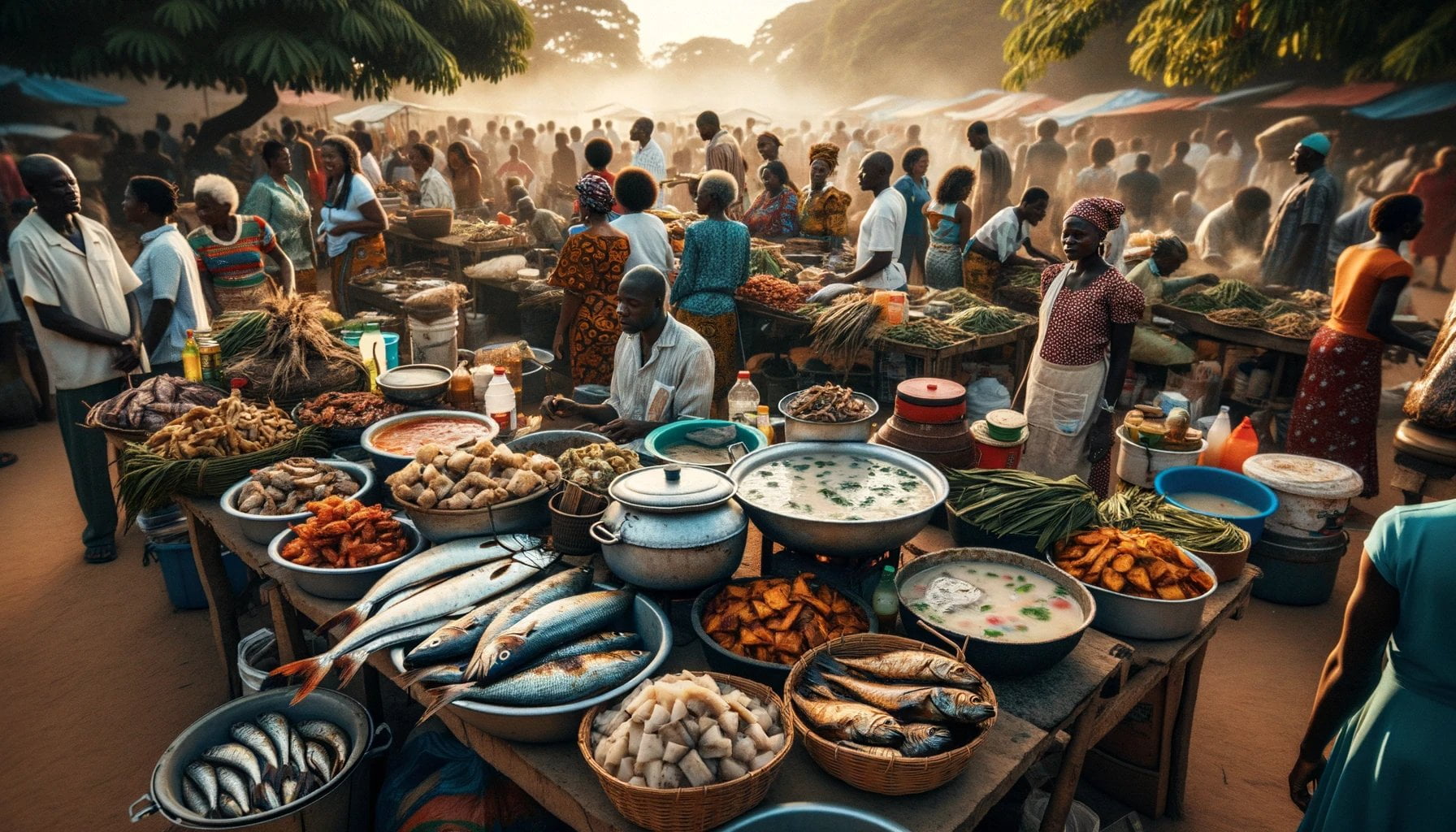
Angola Cuisine: A Delicious Journey Through Africa’s Flavorful History
Ever heard of a cuisine that blends the heart of Africa with the zest of Portugal and Brazil? Well, buckle up, because we’re about to dive into the delicious world of Angolan food! Imagine a culinary melting pot where generations of history and diverse cultural influences come together on your plate. That’s Angola Cuisine in a nutshell.
More Than Just Funge and Pirão (But Seriously, Try Them!)
Now, you might be thinking, “What’s so special about Angolan food?” And honestly? Where do we even begin? First off, you’ve got to try funge and pirão. These are the backbone of many Angolan meals – think of them like fluffy, comforting mounds of goodness made from cassava or cornmeal. And don’t let their simplicity fool you, these staples are incredibly versatile and soak up the flavors of the dishes they accompany.
Muamba de Galinha: A Taste of National Pride
If you want to dive straight into the heart of Angolan cuisine, you HAVE to try Muamba de Galinha. It’s considered the national dish for a reason! Imagine tender, juicy chicken simmered in a rich, flavorful sauce made with palm oil (a staple ingredient in Angolan cooking), okra for a bit of texture, and garlic for that extra punch. It’s seriously comfort food at its finest, and each bite tells a story of Angola’s rich culinary heritage.
From the Ocean to Your Plate: A Seafood Lover’s Paradise
With a coastline stretching over 1,000 miles, it’s no surprise that Angola is a seafood lover’s paradise! Get ready for fresh catches of the day transformed into unique dishes like Calulu and Mufete.
- Calulu: This hearty fish stew is bursting with flavor. Picture this: your favorite fish simmered with okra, palm oil (told you it was a staple!), and a touch of tangy tomato sauce.
- Mufete: This dish is all about simplicity that packs a punch. Imagine perfectly grilled or fried fish served alongside a generous helping of pirão, ready to soak up all those delicious juices.
A Culinary Adventure Across Regions
One of the most exciting things about Angola’s food scene is that it’s not a “one-size-fits-all” situation. Each region has its own unique spin on classic dishes, adding an element of culinary adventure to your trip!
- Luanda: The capital city is a melting pot of flavors, where street food reigns supreme. Get ready for an explosion of tastes and aromas as you explore the city’s bustling markets and food stalls.
- Benguela: Calling all seafood enthusiasts! Benguela, a coastal city, is where you’ll find some of the freshest and most delicious seafood dishes in the country.
- Huíla: Located in southern Angola, Huíla’s cuisine has a distinct Namibian influence, making it a treat for adventurous eaters.
Fresh, Local, and Oh-So-Flavorful
One of the things that makes Angolan food so special is the emphasis on using fresh, locally sourced ingredients. And when it comes to spices, Angola knows how to bring the heat (sometimes literally!). Spices like piri piri peppers (watch out, these little guys are fiery!), djimbi (a type of African basil), and kandji (a type of mustard) add incredible depth and complexity to the dishes.
Street Food: A Culinary Adventure on Every Corner
No exploration of Angolan cuisine is complete without diving headfirst into the world of street food. It’s more than just a quick bite; it’s a way of life. From smoky grilled meats to perfectly ripe fried plantains, the streets of Angola come alive with the irresistible aromas of delicious and affordable treats. It’s the perfect way to experience the true flavors of Angola.
Ready to Embark on a Culinary Journey?
Angolan cuisine is more than just a meal; it’s a vibrant tapestry of history, culture, and tradition. From the comforting warmth of Muamba de Galinha to the fresh, ocean flavors of Calulu, every bite tells a story. So, whether you’re a seasoned foodie or just looking to expand your culinary horizons, a trip to Angola promises an unforgettable gastronomic experience.
Here are some interesting facts about Angola that you might not know: Explore more about facts about Angola by clicking here.
Discover the vibrant tourism in Angola and get inspired to plan your next adventure by clicking here.
Immerse yourself in the rich and diverse culture of Angola. Learn more about Angola culture by clicking here.
Delve into the fascinating history of Angola and uncover its past by clicking here.
Uncover the most famous and breathtaking places in Angola that will leave you in awe. Start your journey by clicking here.
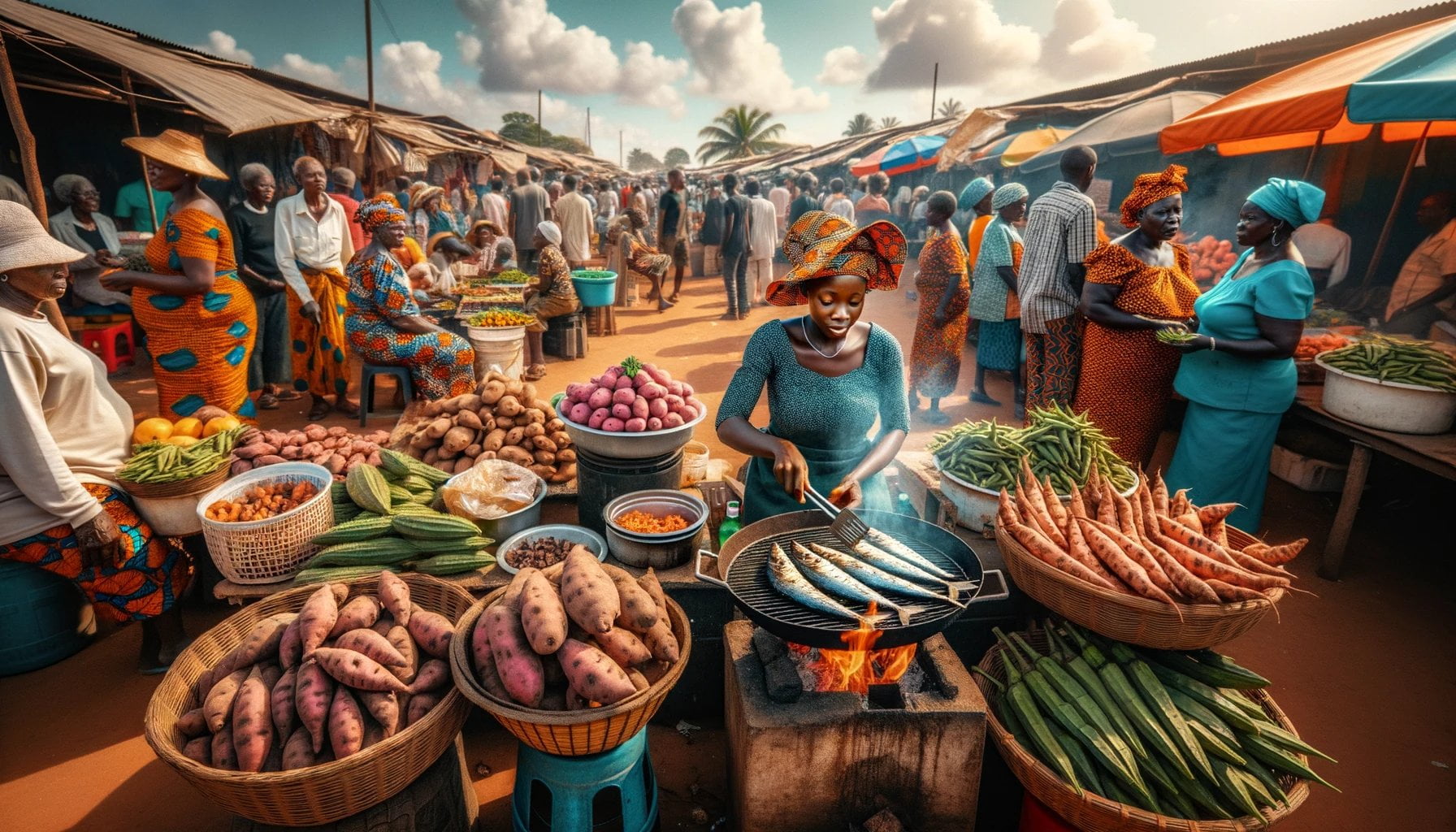
What is the national dish of Angola?
When it comes to Angolan food, one dish stands proud as a national symbol: Moamba de Galinha, also known as Chicken Muamba. This hearty chicken stew, simmered to perfection in a rich and flavorful sauce, truly embodies the essence of Angolan cuisine.
The magic of Moamba de Galinha lies in its unique blend of ingredients. Palm oil, a staple in Angolan cooking, forms the base of the sauce, lending it a rich, earthy flavor. Okra adds a delightful texture, while garlic and chilies provide a subtle kick. It’s this harmonious fusion of Portuguese, African, and even a touch of Brazilian influence that makes Moamba de Galinha a true representation of Angola’s culinary heritage.
While Moamba de Galinha rightfully claims the title of “national dish,” Angola’s culinary landscape is far from one-dimensional. Take Kizaca, for example. This traditional stew, with its roots in Portuguese cuisine, has evolved over time to become a cherished staple in Angola. Kizaca exemplifies how different cultures can intersect and influence each other, even through something as simple as a shared love for a good stew.
Angola’s tropical climate and abundance of natural resources have blessed its cuisine with a diverse and flavorful palate. From fresh seafood to exotic fruits and vegetables, there’s always something new and exciting to discover in Angolan cooking. It’s a delicious reminder that food is more than just sustenance; it’s a reflection of history, culture, and the simple joy of bringing people together around a shared table.
What do Angolans eat for breakfast?
Angolan breakfasts are a delightful fusion of African, Portuguese, and Brazilian flavors, offering a diverse range of options to kickstart the day. From hearty stews to lighter, plant-based choices, there’s something to satisfy every palate. Let’s take a peek into a typical Angolan morning and discover the culinary delights that await.
The Staple Stew: Calulu
No exploration of Angolan breakfasts would be complete without mentioning Calulu, a beloved stew that frequently graces breakfast tables across the country. Calulu is incredibly versatile and can be prepared with a variety of ingredients. Dried fish lends a taste of the sea, while meat adds a richer, more savory flavor. For those seeking a vegetarian option, Calulu can also be made entirely with vegetables, providing a wholesome and flavorful start to the day.
No matter the chosen ingredients, Calulu is often accompanied by Funge, a cooked cornmeal porridge that can be either savory or sweet, depending on personal preference. This dynamic duo forms a match made in Angolan food heaven, with the soft, fluffy Funge acting as the perfect vessel for soaking up the flavorful broth of the Calulu.
A Vegetarian Favorite: Kizaca
For those seeking a plant-based start to the day, Kizaca emerges as a strong contender. This beloved vegetarian dish showcases the resourcefulness of Angolan cooks, transforming simple ingredients like okra, tomatoes, and palm oil into a symphony of flavors. Kizaca is a testament to the fact that vegetarian options in Angolan cuisine are far from an afterthought; they are an integral part of the country’s culinary tapestry.
Embracing the Ocean’s Bounty
Angola’s extensive coastline ensures that seafood features prominently in many dishes, and breakfast is no exception. Imagine waking up to the aroma of grilled sardines or enjoying a plate of fried octopus alongside your morning coffee. For those who appreciate more intense flavors, dried shrimp can add a unique umami punch to breakfast dishes.
A Journey Through Regional Delights
Just like any country with a diverse landscape and cultural heritage, Angolan cuisine undergoes fascinating transformations as you travel from one region to another. Along the coast, the ocean’s bounty takes center stage, with seafood reigning supreme. Moving inland, the focus shifts to locally grown vegetables and grains, highlighting the agricultural richness of each region.
While this glimpse into Angolan breakfasts offers a taste of the country’s diverse culinary traditions, it’s just the tip of the iceberg. There are countless hidden gems and family recipes passed down through generations, waiting to be discovered. So, if you ever find yourself in Angola, don’t hesitate to ask a local about their favorite breakfast dish – you might just stumble upon your new favorite way to start the day!
What is the traditional food funge in Angola?
In the heart of Angolan cuisine lies funge, a warm, hearty porridge that holds a place of honor on almost every Angolan table. Unlike its oat-based counterparts, funge is made from finely ground cassava or corn flour, giving it a unique texture and a subtle, earthy flavor. More than just a side dish, funge is the foundation of many Angolan meals, much like rice or bread in other cultures.
The beauty of funge lies in its versatility. Its slightly sticky texture acts like a blank canvas, eagerly absorbing the flavors of the stews and sauces it’s served with. It’s this ability to complement a wide range of dishes that has solidified funge’s status as an Angolan staple.
Just like any beloved dish passed down through generations, funge boasts regional variations that add to its allure. In some parts of Angola, cassava flour reigns supreme, lending the funge a smooth, almost elastic texture. In other areas, cornmeal takes center stage, resulting in a slightly coarser and grainier feel. These subtle variations are a testament to the diversity within Angolan cuisine and make exploring its nuances a delightful adventure.
Even the methods of cooking and seasoning funge differ from region to region, reflecting the unique culinary traditions and preferences of each community. This means that as you traverse Angola, you’ll encounter a world of funge flavors, each one offering a distinct and delicious experience.
While funge often plays a supporting role to flavorful stews and sauces, it’s fully capable of taking center stage as a satisfying main course. Imagine digging into a bowl of funge topped with a rich and spicy kizaca, a traditional tomato-based stew simmered with smoky flavors. Alternatively, picture savor a comforting muamba de galinha, a flavorful chicken and okra stew that warms you from the inside out. In either scenario, funge provides the perfect base for these hearty and satisfying dishes.
So, the next time you find yourself yearning for a culinary journey, remember the name “funge”. This simple yet incredibly versatile dish holds the key to unlocking a world of flavor and traditions within Angolan cuisine.
Is Angolan Food Spicy?
Angolan food is a captivating blend of African and Portuguese influences, resulting in a cuisine that tantalizes taste buds with its diverse flavors. When it comes to spiciness, Angolan cuisine offers an adventurous yet approachable experience.
A Fusion of Flavors
African spices dance harmoniously with Portuguese seasonings in Angolan cuisine, creating a unique and exciting culinary tapestry. This fusion results in dishes that are both comforting and intriguing, with layers of flavor that unfold with each bite.
Exploring the Classics
Muamba de Galinha, Angola’s celebrated national dish, exemplifies the country’s balanced approach to spice. While piri-piri peppers, known for their fieriness, often make an appearance in Muamba de Galinha, their heat is typically subdued, adding a gentle warmth rather than an overpowering burn.
Funge, the ever-present companion to many Angolan meals, provides a neutral base that balances the flavors of spicier dishes. Made from cassava or corn flour, funge offers a mild and slightly sweet flavor that contrasts beautifully with the boldness of some Angolan stews and sauces.
A Spectrum of Spice
Rather than aiming for intense heat, Angolan cuisine embraces a more nuanced approach to spice. Herbs and spices like coriander and bay leaves are used to create depth and complexity, adding subtle layers of flavor that linger on the palate.
Piri-piri peppers, while capable of delivering a fiery kick, are often used sparingly, their heat mellowed by other ingredients. This balanced approach ensures that the spiciness enhances rather than overpowers the overall flavor profile of the dish.
A Culinary Adventure Awaits
Angolan food is best described as a slow burn rather than an explosion of heat. It’s about savoring the intricate interplay of flavors, with spice playing a supporting role that enhances rather than dominates. If you’re looking for a culinary experience that excites your taste buds without setting them on fire, Angolan cuisine is an adventure worth embarking on.
What is the famous food in Angola?
Angolan food is a vibrant fusion of Portuguese, African, and Brazilian influences, resulting in a cuisine that is both diverse and delicious. This unique blend of cultures is reflected in the country’s most popular dishes, offering a range of flavors and textures to explore.
Funge: The Heart of Angolan Cuisine
Funge, a porridge-like dish made from cassava or corn flour, holds a place of honor as one of Angola’s most famous foods. This versatile staple is a common sight on Angolan tables, often served alongside stews, sauces, and grilled meats. Its neutral flavor and slightly sticky texture make it the perfect accompaniment for absorbing the rich flavors of the dishes it’s served with.
Muamba de Galinha: A National Treasure
No exploration of Angolan cuisine would be complete without mentioning Muamba de Galinha, often considered the national dish of Angola. This flavorful stew, made with chicken, palm oil, okra, and a blend of spices, perfectly captures the essence of Angolan flavors. The chicken is cooked to tender perfection, while the palm oil adds a rich, nutty flavor. Okra lends a slightly slimy texture, and the spices provide a warm and inviting aroma.
Beyond the Classics
While funge and Muamba de Galinha are undoubtedly two of Angola’s most renowned culinary offerings, the country’s cuisine extends far beyond these staples. Other notable dishes include:
- Kizaca: A hearty stew made with okra, tomatoes, and palm oil, often served with funge.
- Calulu: A flavorful fish stew, typically made with tomatoes, onions, and okra.
- Mufete: Grilled fish served with plantains, sweet potatoes, and sometimes a spicy sauce.
Street Food Delights
No culinary journey through Angola is complete without experiencing the vibrant street food scene. From grilled meats to fried plantains, Angola’s streets are alive with the sights, smells, and sounds of delicious and affordable treats. Street food offers a fantastic way to sample authentic Angolan flavors and experience the country’s culinary culture firsthand.
What is Angola best known for?
Angola, a country located on the southwestern coast of Africa, is renowned for its stunning natural beauty, diverse wildlife, and rich cultural heritage. Among its many treasures, Angola boasts a fascinating culinary scene that reflects its history and the various cultures that have shaped it.
Funge: A Culinary Icon
One of the things Angola is best known for, at least in the culinary world, is Funge, a cornmeal mush that holds a place of honor as the national dish. This versatile staple is a cornerstone of Angolan cuisine, often accompanying stews, sauces, and grilled meats. Whether enjoyed plain or as a base for other flavors, funge is an integral part of the Angolan culinary experience.
Cocada Amarela: A Sweet Delight
For those with a sweet tooth, Angola offers Cocada Amarela, a spiced coconut porridge that perfectly embodies the country’s vibrant flavors. This warm and comforting dessert features a unique blend of spices that varies from region to region, making each encounter with Cocada Amarela a distinct taste adventure.
Calulu de Peixe: A Seafood Symphony
With its vast coastline, it’s no surprise that Angola boasts a rich tradition of seafood dishes. Calulu de Peixe, a hearty fish and vegetable stew, is a prime example of how Angola utilizes its abundance of fresh seafood. The stew features tender fish simmering in a flavorful broth, often flavored with tomatoes, onions, and palm oil, creating a symphony of textures and tastes that is sure to delight seafood enthusiasts.
The Allure of Angolan Street Food
No culinary exploration of Angola would be complete without experiencing the vibrant street food scene. From sizzling grilled meats to perfectly fried plantains, Angolan street food offers a tantalizing glimpse into the country’s diverse culinary traditions. It’s an affordable and delicious way to experience authentic Angolan flavors and immerse yourself in the local culture.
While Angolan cuisine is undeniably a highlight, the country has much more to offer beyond its culinary scene. Angola is also known for its stunning landscapes, ranging from towering mountains to sprawling deserts and pristine beaches. And let’s not forget the warmth and hospitality of its people, who contribute to the country’s unique charm.
Is Fufu a National Dish?
While fufu isn’t officially recognized as a national dish in any specific African country, it holds a significant place in the culinary traditions of many West African nations, including Ghana, Nigeria, and Sierra Leone. This starchy side dish, typically made from cassava, plantains, or yams, is a testament to the resourcefulness and culinary ingenuity of West African cultures.
The beauty of fufu lies in its simplicity and versatility. The process of making fufu involves boiling starchy root vegetables and then pounding them into a dough-like consistency. This labor-intensive process often involves a rhythmic pounding using a mortar and pestle, creating a sense of community and tradition around food preparation.
Fufu’s neutral flavor profile makes it an ideal accompaniment to a wide variety of soups, stews, and sauces. Its soft, doughy texture is perfect for scooping up flavorful bites of food, acting as a delicious and satisfying alternative to utensils.
While fufu might not hold an official “national dish” title, its presence in West African cuisine is undeniable. It represents a shared cultural heritage, a testament to the ingenuity of transforming simple ingredients into a comforting and nourishing staple. Fufu’s enduring popularity speaks volumes about its importance as both a culinary and cultural symbol in West Africa.
Is fufu the same as funge?
While both fufu and funge are starchy staples in various African cuisines, they are distinct dishes with unique characteristics and regional variations.
Fufu: A West African Staple
Fufu is predominantly found in West African countries like Ghana, Nigeria, and Togo. It typically involves a labor-intensive process of boiling starchy root vegetables like cassava, plantains, or yams and then pounding them into a smooth, dough-like consistency. Fufu is known for its dense, chewy texture and its ability to soak up the flavors of accompanying soups and stews.
Funge: An Angolan Favorite
Funge, on the other hand, is more prevalent in Central and Southern African countries like Angola and the Democratic Republic of Congo. Unlike the pounding method used for fufu, funge is made by cooking cassava or corn flour with water, creating a porridge-like consistency. While funge can vary in texture depending on the ratio of flour to water, it is generally smoother and less dense than fufu.
Regional Variations and Shared Heritage
It’s important to note that both fufu and funge have regional variations within their respective areas of prominence. Different communities may use different types of starches, resulting in subtle variations in flavor and texture. Despite their differences, both fufu and funge represent a shared culinary heritage, highlighting the importance of starchy staples in many African cuisines. Their enduring popularity is a testament to their versatility, affordability, and cultural significance.
What is Africa’s national food?
Africa, with its 54 diverse countries and countless ethnic groups, is a continent bursting with culinary riches. Due to this vast cultural tapestry, it would be impossible to pinpoint a single dish as “Africa’s national food.” Each country boasts its own unique culinary traditions, reflecting its history, geography, and cultural influences.
Attempting to choose a single national dish for the entire continent would be like trying to select one dish to represent all of Europe or Asia. It simply wouldn’t do justice to the incredible diversity and richness of African cuisine as a whole.
Celebrating Culinary Diversity
Instead of searching for a single national dish, it’s far more enriching to delve into the culinary traditions of individual African countries. Each country has its own set of staple ingredients, cooking techniques, and flavor profiles that reflect its unique identity.
Exploring Angolan Cuisine
Let’s take Angola, for example. This Southern African nation boasts a fascinating cuisine that blends indigenous African flavors with Portuguese and Brazilian influences. Some of Angola’s most iconic dishes include:
- Funge: A cornmeal porridge that serves as a staple accompaniment to many meals.
- Muamba de Galinha: A flavorful chicken stew cooked in palm oil with okra, garlic, and spices.
- Calulu: A hearty fish stew made with tomatoes, onions, and okra.
A Culinary Adventure Awaits
Exploring the diverse culinary landscape of Africa is an adventure in itself. Each country offers a unique gastronomic experience, from the spicy tagines of Morocco to the fragrant jollof rice of West Africa and the hearty stews of East Africa. By embracing the culinary diversity of the continent, we can gain a deeper appreciation for the richness and complexity of African culture as a whole.
What meat is served in Angola’s national dish?
Angola’s celebrated national dish, Muamba de Galinha, features tender, flavorful chicken as its star ingredient. This beloved dish, often translated as “Chicken Muamba” in English, perfectly embodies the country’s unique blend of African, Portuguese, and Brazilian culinary influences.
The chicken in Muamba de Galinha is simmered to perfection in a rich and savory sauce, often made with a combination of palm oil, garlic, onions, tomatoes, and a medley of spices. The palm oil adds a distinct richness and depth of flavor, while the garlic and spices infuse the dish with warmth and aroma. Okra is another common addition, lending a slightly thick and viscous texture to the sauce.
Muamba de Galinha is typically served with funge, a thick porridge made from cassava or cornmeal. The funge acts as the perfect accompaniment, soaking up the flavorful sauce and creating a satisfying and complete meal.
This dish holds a special place in Angolan culture and is often served during special occasions and celebrations. It’s a testament to the country’s rich culinary heritage and a must-try for anyone looking to experience the authentic flavors of Angola.
